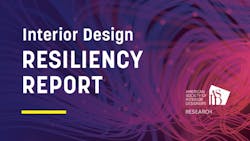Exploring the Key Takeaways from ASID’s Interior Design Resiliency Report
How resilient is the interior design industry in the face of major challenges? The interior design community is composed of creative problem-solvers who exercise resilience on a daily basis—navigating through project challenges, client demands and rapid changes in the world.
ASID surveyed the interior design community and initiated discussions on resilience with design practitioners and industry partners and embarked on a research project to further investigate interior design resilience in partnership with Cosentino, Benjamin Moore and Emerald.
Lead Resiliency Report author and ASID Director of Research & Knowledge Management, Susan Chung, Ph.D., explores key takeaways from the Resiliency Report and her views on the future of design.
The Design Industry’s Resilience
The ability to prepare and plan for, absorb, recover from, and more successfully adapt to adverse events is essential for not only the buildings and spaces we design to withstand natural disasters, but also in support for the people we design the space for (personal resilience) and among the community that we design the space with (industry resilience) as we move forward.
As we continue to experience disruptions in our daily lives, at work, in our neighborhoods and around the world, resilience becomes a necessity in all aspects. The pandemic offers a platform to exercise and test our resilience and better prepare for the future.
The Industry’s Physical, Mental & Social Well-Being
Our lives are multifaceted and intricately woven with the external and larger society. Our social well-being was lowest during this time of physical distancing, and we experienced burnout, which relates to our overall well-being.
Respondents to ASID's survey ranked their well-being across three categories on a scale of 1 to 10, revealing a high correlary with burnout:
- Physical well-being (8.0)
- Mental well-being (7.4)
- Social well-being (6.5)
Many factors from the pandemic have made our physical, mental and social well-being vulnerable. We are challenged with constant changes from the uncertainties of the current situation, demands from work, additional pressures from personal lives, etc. and need to pause, recharge and find balance. This may be difficult (or nearly impossible!) when looking at just the immediate situation, but we need to think long-term and invest in our personal health and well-being in order to sustain and thrive.
Adjustments With Technology
We transitioned from work to home and had to make adjustments. Changes were focused on technology, infrastructure, resources and support. Overall, this became an experiment to test out widespread remote work, creating new habits that would be good to carry over (e.g., increased focus, collaboration, sharing, etc.).
We had to guide clients through the process of learning how to think through changes for the immediate, intermediate and long-term, while also juggling challenges in virtually communicating the physicality of design. With changes in how we work and communicate with clients, we need to think through changes in how we do business.
[Related: How Technology Is Humanizing Office, Retail and Healthcare Design]
Technology proved to be a critical tool in our lives and a necessity for moving forward into the future. We should still take a moment to assess the needs and priorities of technology, and never disregard the power of presence and physical connection.
Technology is being used not only in the design process and communication, but also entrenched in projects. Clients are examining technological needs in their operations and looking to incorporate them within the physical space as well; for example, touchless technology was the top technology advancement survey respondents looked forward to.
The demand for more research supported by data will increase and clients may also look to technologies that gather data to make informed decisions beyond the design of the physical space.
Major Industry Changes & Priorities
Changes are inevitable, with some that are fundamentally necessary for us to grow. The disruption of COVID-19 has elevated many issues in society, policy, operations, processes, behaviors, physical spaces, etc. But what really needs to change and why? This should be a time to re-evaluate and challenge the industry and profession to reinvent a better future.
Survey respondents were asked how much change they expected from the pandemic, the majority of which anticipated some or major levels of change:
- No change - 2%
- Slight change - 7%
- Some change - 47%
- Major change - 40%
- Complete transformation - 4%
The question about the necessity of change reveals a range of priorities among survey respondents:
- 7% - Unnecessary
- 11% - Somewhat Unnecessary
- 12% - Neutral
- 36% - Somewhat Necessary
- 34% - Necessary
We should keep in mind that we are interconnected with each other and with the world we live in. The priorities that have emerged from the pandemic should be weighed against the expected consequences of those changes. For example, priorities for health and wellness at times comes at the cost of endangering environmental sustainability, and efforts to collect data can compromise privacy and trust. We need to come together collectively, not just within the interior design community, but with other industries and peoples, to converse and build a healthier, safer and better future.
View the full Resiliency Report and all of the Society’ findings here.
About the Author: Susan Chung, Ph.D., focuses on the impact of design research. As Director of Research & Knowledge Management for ASID, she connects design with research to improve human experiences in the interior environment, translates research into applicable design implications and conducts research projects that create meaningful positive impacts.
Read Next: Adapting Design Thinking to Ensure a Healthier, More Sustainable and Connected Future
About the Author

firstName lastName
i+s partners with design practitioners and other industry experts to deliver informative and engaging content on a variety of topics related to commercial interior design, from the latest trends, research and technology to innovative projects, products and educational CEUs. Interested in becoming a contributor? Contact us today!
